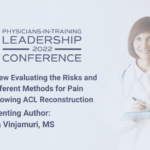Abstract | April 5, 2022
A Systematic Review Evaluating the Risks and Benefits of Different Methods for Pain Management Following ACL Reconstruction
Learning Objectives
- Upon completion, learners should be better prepared to interpret the recommendations for pain management following ACL reconstruction. Additionally, learners should be able to familiarize themselves with multimodal pain management strategies and their pros and cons.
Background/ Knowledge Gap: Anterior Cruciate Ligament injuries are commonplace in non-contact sports and often necessitate surgical intervention. There are numerous options for controlling pain after an ACL reconstruction which influences the time spent in recovery and how soon a patient can return to play. In recent years, sport surgeons have been reevaluating the use of opiates in managing pain and have been opting to multimodal pain management strategies. The objective of this systematic review is to evaluate the effects of multimodal pain management strategies compared to pain management strategies involving opiates in patients who have undergone ACL reconstruction. The secondary objective will investigate if the multimodal pain management therapy, compared to opioid therapy on pain scores in patients who have undergone ACLR differs according to certain subgroups including sex/gender, etc. Additionally, we will investigate the effects of multimodal pain management strategies versus opioid therapy in patients who have undergone ACLR on secondary outcomes including return to play, and improvement of selfreported measures.
Methods/Design: Study participants must include patients who have undergone ACL reconstruction and were prescribed medication to manage pain. The population includes both males and females, between the age of 15-40 years old. This demographic represents individuals most engaged in sports that are prone to ACL injury and therefore need reconstructive surgery.
Results/Findings: To determine the validity of eligible articles and to reduce variability in study results, the reviewers agreed on specified study aims and inclusion criteria before conducting the analysis. Different quality assessment tools will be used to determine the susceptibility of types of bias. Quality assessment tools will be used to determine the validity of the study and the potential for bias. These different tools will be used after screening the articles to help with quality data extraction and to rate the overall risk of bias.
Conclusions/ Implications: Data will be taken from each study/ article based on the type of interventional/ pain management strategy used and compared to assess the risk and benefits of each method. The results will be reported with both quantitative and qualitative assessment to provide recommendations to sports surgeons on the most effective pain management strategy.
References and Resources:
- Pain management after outpatient anterior cruciate ligament reconstruction
- A practical review of the mechanisms of pain and pain management following ACL reconstruction, Noonan et al.
- Ultrasound Guided Adductor canal block versus femoral nerve block for arthroscopic ACL repair under general anesthesia.
- Postoperative Analgesia with Saphenous block appears equivalent to femoral nerve block in ACL reconstruction.
- Pain management for Ambulatory Arthroscopic Anterior Cruciate Ligament reconstruction: Evidence based recommendations from the society for ambulatory anesthesia.
- Can We Eliminate Opioids After Anterior Cruciate Ligament Reconstruction? A Prospective, Randomized Controlled Trial

